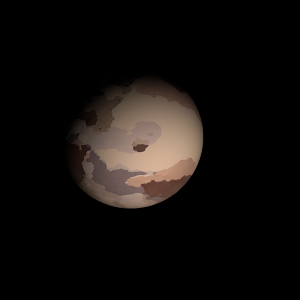|
|
Space Astro
|
Info for exoplanet "Vosdra"
| Scientific (actual) data |
|---|
| Name | GJ 3082 b |
| Planet status | Confirmed |
| Mass sini | 0.02759 |
| Orbital period | 11.942 |
| Semi major axis | 0.079 |
| Orbit eccentricity | 0.26 |
| Discovered | 2020 |
| Updated | 2021-03-29 |
| Omega | 100 |
| K | 4.2 |
| Publication | Published in a refereed paper |
| Detection type | Radial Velocity |
| Mass measurement type | Spectrum |
| Star name | GJ 3082 |
| Right ascension | 18.64° |
| Declination | -53.94° |
| Mag v | 11.1 |
| Star distance | 16.63 |
| Star mass | 0.47 |
| Star sp type | M3V |
| Star alternate names | HIP 5812 |
| Wikipedia article | GJ 3082 b |
Back
| |
| Fictional info (?) |
|---|
| Suggested name | Vosdra |
| Planet type | Cold planet |
| As seen relative to the fixed stars, it rotates on its axis exactly two times for every two revolutions it makes around GJ 3082.
The polar regions are constantly below 207°K (-66°C). |
| Atmosphere | Ethane | 59% |
| Hydrogen | 23% |
| Methane | 14% |
| Oxygen | 3.3% |
| Water vapor | 0.66% |
| Ozone | 0.022% |
| 2H2O | 0.0048% |
| Atmospheric pressure | 15 bar |
 |
| No known satellites |
| Google search for Vosdra |
|
Website by Joachim Michaelis
|
|
|
|